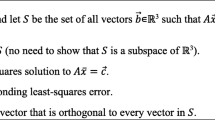Abstract
We describe how elementary Linear Algebra can be taught successfully while introducing students to the concept and practice of ‘mathematical proof’.This is done badly with a sophisticated Definition–Lemma–Proof–Theorem–Proof–Corollary(DLPTPC) approach; badly – since students in elementary Linear Algebra courses have very little experience with proofs and mathematical rigor. Instead, the subjects and concepts of Linear Algebra can be introduced in an exploratory and fundamentally reasoned way. One seemingly successful way to do this is to explore the concept of solvability of linear systems first via the row echelon form (REF). Solvability questions lead to row and column criteria for a REF that can be used repeatedly to: compute subspaces, settle linear (in)dependence, find inverses, perform basis change, compute determinants, analyze eigensystems etc. If these subjects are explained heuristically from the first principles of linear transformations, linear equations, and the REF, students experience the power of a concept–built approach and reap the benefit of deep math understanding. Moreover, early ‘salient point’ proofs lead to an intuitive understanding of ‘math proof’. Once the basic concept of ‘proof’ is ingrained in students, more abstract proofs, even DLPTPC style expositions, on normal matrices, the SVD etc. become accessible and understandable to sophomore students. With the help of this gentle early approach, the concept and construct of a ‘math proof’ becomes firmly embedded in the students' minds and helps with future math courses and general scientific reasoning.
Similar content being viewed by others
REFERENCES
Blanchard, P., Devaney, R.L. and Hall, G.R.: 1996, Differential Equations, PWS (paperback); 2nd ed., Brooks/Cole, 2002.
Carlson, D.: 1993, ‘Teaching linear algebra: must the fog always roll in?,’ The College Mathematics Journal 24, 29–40.
Dorier, J.L. and Sierpinska, A.: 2001, ‘Research into the teaching and research of linear algebra,’ in D. Holton (ed.), The Teaching and Learning of Mathematics at University Level, An ICMI Study, Kluwer, p. 255–273.
Harel, G.: 2000, ‘Three principles of learning and teaching mathematics: Particular reference to linear algebra: Old and new observations’, in Jean-Luc Dorier (ed.), On the Teaching of Linear Algebra, Kluwer, p. 177–190.
Kostelich, E.J. and Armbruster, D.: 1996, Introductory Differential Equations, from linearity to chaos, Addison-Wesley, 645 pp.
Lay, D.: 1996, Linear Algebra and its Applications, 2nd ed. 2000, Addison-Wesley, 485+ pp.
The Linear Algebra Curriculum Study Group: 1993, ‘Recommendations for a first course in linear algebra,’ The College Mathematics Journal 24, 41–46.
Piaget, J. and Garcia, R.: 1983, Psychogenesis and the History of Science, Columbia U Press, New York.
Uhlig, F.: 2002a, Transform Linear Algebra, Upper Saddle River: Prentice-Hall, 504 + xx p.
Uhlig, F.: 2002b, 'A new unified, balanced, and conceptual approach to teaching linear algebra,’ to appear in Linear Algebra and its Applications, vol. (Haifa 2001 Conference issue), 11p. Or see http://www.auburn.edu/~uhligfd/TLA/download/tlateach.pdf
Author information
Authors and Affiliations
Rights and permissions
About this article
Cite this article
Uhlig, F. The Role of Proof in Comprehending and Teaching Elementary Linear Algebra. Educational Studies in Mathematics 50, 335–346 (2002). https://doi.org/10.1023/A:1021245213997
Issue Date:
DOI: https://doi.org/10.1023/A:1021245213997




